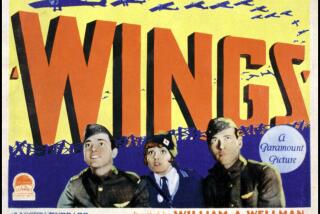Parachute Tester Has New Wrinkle : He Straps a Video Camera to His Stomach and Bails Out
- Share via
Poor Doris Buehrer.
Her worries began when her son Bob was in grade school. That’s when he started designing and launching model rockets that sometimes went amok at 60 or 70 m.p.h.; he graduated to go-carts that tended to malfunction at freeway speeds.
“I almost wiped myself out more than once,” admits Bob Buehrer, now 31.
Today when friends ask what her boy is up to, Doris Buehrer must explain that he’s out in California, test-jumping parachutes.
“I didn’t tell my parents in Minnesota that I was doing this for quite awhile, but then my roommate accidentally blabbed that I was testing these things,” Bob Buehrer said during an interview in the living room of his Whittier home.
The information leak called for emergency tactics. With video tapes of some of his test jumps in hand, Buehrer made a trip home to St. Paul. He showed his mother and father the films and told them the job is no more risky than his childhood science projects.
“The thing (parachute) may not fly well, but you’re going to get it into the air,” he said. “Although there is a chance that it could rip or that it could fly poorly enough that I wouldn’t want to land it. . . .”
Designers have been making canopies for long enough now that it’s rarely a question of “Is it going to work?” Buehrer said; now what they want to know is “How well is it going to work?”
The latter question is what got Buehrer into this business.
He said he had no particular craving for the adrenaline rushes sky diving provided when he got into the sport eight years ago. Nor did he want to prove he was a daredevil. He doesn’t quite look the part, anyway. A lanky, genial fellow, he’d more likely be cast as an absent-minded inventor, always lost in some project.
In fact, Buehrer identifies himself as an “inventor-creator type person.” He owns a metal fabrication shop in El Monte, where he builds sophisticated devices that solve the problems customers bring to him. For instance, he created a video camera mount that can track sky divers in free-fall competition as far as two miles away.
Buehrer said he took up sky diving because he felt there were too few challenges left in aviation, a hobby he had turned to in the mid-’70s. He saw that no one had a system for scientifically evaluating the performance of canopy designs, and made it his project to create such a method.
Because reserve parachutes, containers and harnesses are regulated by the Federal Aviation Administration, companies that make those items have generally accepted ways of evaluating their product.
But main parachutes need not be certified by the FAA, so there are no industrywide standards for the design and testing of main canopies, Buehrer said.
Military’s Methods
The military has its own methods for evaluating parachute performance. A small (14 men) crew of test jumpers at the Naval Parachute Test Range at China Lake uses range-mounted cameras, lasers, radars and other elaborate equipment in their program, according to Master Chief Robert Hudson, who heads the operation. But civilian manufacturers cannot afford to use such technology to obtain performance data, he said.
“It’s pretty ingenious what he (Buehrer) is doing,” said Hudson. “No one else, to my knowledge, has thought to do that.”
Many commercial manufacturers of sports parachutes simply strap their latest designs onto the backs of willing staff members and friends, toss them out of airplanes, and later ask how the ride felt.
“That kind of testing has always been extremely subjective,” said Buehrer. “It’s influenced by everything from what he (the jumper) ate that morning to how he feels about the guy that made the parachute. The opinion is nice, but it doesn’t solve any design problems.”
Several years ago, Buehrer’s friend, parachute designer Bill Gargano of Quantum Parachutes in Davis, sent Buehrer a new canopy design and asked him to try it out.
Buehrer strapped a video camera to his belly and pointed it at his face and the sky where the canopy would open above him. He taped an altimeter to the top of his helmet so the camera would record a constant altitude read-out as he was descending.
Buehrer was equipped with audio so he could give a running report of the parachute’s performance.
Has Edge With System
The system worked so well that Gargano, and then other designers, began using Buehrer regularly as a test jumper.
Dan Poynter, president of the Parachute Industry Assn., said Buehrer is “probably way ahead of everybody else” with the particular system he has devised to test parachutes.
“What’s so unusual about what he’s done is that he’s captured the performance--and sometimes the malperformance--of the parachute on film,” said Poynter, author of “The Parachute Manual,” considered to be the standard guide to parachuting.
Designer Gargano said: “The work he’s done for me has saved me hours and hours (of trial and error). His input is absolutely what makes the final product.”
A typical test jump, as recorded on video tape, begins with the camera careening about the cargo area of a small plane as Buehrer rearranges his position in preparation for the jump. He records the date and place on the sound track.
The jump Buehrer screened at his home on a recent morning was made in Lodi in 1984. At 10,000 feet, Buehrer toppled out of the doorway and fell freely for a few seconds.
If the camera could take in the entire scene at this point, it would look as if the tin woodsman were tumbling through the sky--Buehrer was burdened with cameras and hardware, with the altimeter atop his head.
He managed a smile at the camera. Then, when the parachute deployed, he got down to business, checking first to see that the shock of the canopy opening hadn’t jarred the video camera out of position.
The opening is the most critical part of the jump, Buehrer said. The jumper is being slowed from a free-fall speed of around 120 m.p.h. to about 10 m.p.h. in the course of a few seconds. If there’s an error in the parachute adjustment or design, or if the weight of the load is too great, the opening jolt can be so severe that Buehrer’s thighs are bruised by the harness straps, and his face is cut by the risers, which are part of the rigging. It’s even possible for the canopy to rip or explode.
Once he’s safely falling, Buehrer refers to a list of 15 test maneuvers, which he has strapped to his wrist. His job at this point is to “torture” the parachute, according to Gargano, to see if he can get it to misbehave.
Buehrer turned the parachute to the left and right, calling out “start” and “stop” during the maneuver so that an engineer reviewing the tape later would be able to see how quickly the canopy responded. Gargano is able to read the shadows that slither across the fabric for clues as to how to make the canopy perform better.
“All I do is go up and trash the parachute. I couldn’t interpret this stuff myself,” Buehrer said.
The inventor forced the parachute into a stall, and for a moment the horizon appeared, tipping madly. Buehrer dropped his nonchalant test-pilot voice long enough to go “Whoooooa!”
The canopy crumpled, then it snapped back full again, buffeting the man below.
“Some parachutes get real weird at this stage (while stalling),” Buehrer said. “Bill (Gargano) doesn’t like stalls. He gets a heart attack watching these tapes, so I kind of tease him a little bit (by exaggerating his sound effects).”
Once below 2,500 feet, Buehrer said he restricts himself to “less radical maneuvers that I know I’m not going to get in trouble with.”
In all he has up to 15 minutes of air time per jump in which to put the canopy through its paces. He repeats the process several times in a working day. One company pays him $200 to $300 for a day of falling. When working for his friend Bill Gargano, he often trades test jumps for parachutes.
Buehrer’s reaction to the occasional dud of a parachute design is not terror, but annoyance.
In one instance, a parachute opened on cue, but the trim had been altered so that the canopy angle was too flat. It stalled almost immediately, and Buehrer realized that he was not going to be able to ride it to the ground.
“I was bummed out, disappointed,” he said.
All the equipment Buehrer wears can get in the way when he’s trying to jettison a defective parachute. In this case, he managed to cut away the main canopy and deploy his reserve, grumbling all the time because the reserves are a pain to repack, he said.
That mishap inspired Buehrer to invent adjustable risers so the flight trim can be corrected mid-flight on a test jump.
Buehrer also invented a special slider (a piece of fabric that slows the canopy’s opening shock) that can be removed after the canopy is inflated so it doesn’t get in the way of his video cameras.
(Buehrer said the military adopted his device because without the extra piece of fabric flapping in the wind, the parachute can land more quietly.)
One day Buehrer was testing the slider device on a large parachute that required a 350-pound load. Another sky diver and Buehrer strapped themselves together to make up the required weight.
They left the plane at 10,000 feet; then the slider jammed so that the canopy could not open.
One of the men observed aloud that they had a malfunction.
“You want me to go?” Buehrer asked his companion, as if they’d just had a spat.
“Yeah, you’d better,” the second jumper said.
Buehrer unsnapped the harness that held them together and jettisoned himself.
“Now I’m under this inky-dinky little reserve parachute with all this camera gear and no wind (landing is more difficult without wind),” he remembered. Buehrer said he was worried about damaging his equipment.
Both men and their equipment landed unharmed.
More to Read
Inside the business of entertainment
The Wide Shot brings you news, analysis and insights on everything from streaming wars to production — and what it all means for the future.
You may occasionally receive promotional content from the Los Angeles Times.










